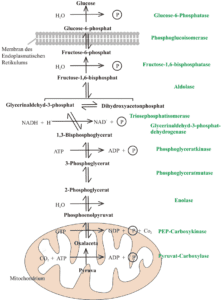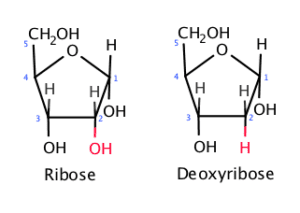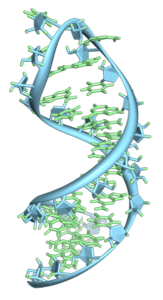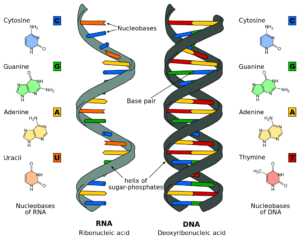Chemical Pathways
Chemical pathways are the way a cell changes one chemical compound to another. Many times, these chemical pathways produce intermediate chemicals on the way to producing the final product.
All life needs to take in nutrients from the environment in order to continue living. This might be everything from simple nutrients to eating another creature.
The common problem with the digestion of nutrients is the chemistry involved. When a nutrient is ingested, often it has to be broken down into simpler nutrients which subsequently need to be reassembled into new tissue or used for energy.
All of these processes take chemical pathways that are usually complicated and require enzymes to function efficiently.
A chemical pathway is a well-regulated stepwise production of one substance from others.
Starting a Chemical Pathway

Glucose Pathway: By C. Mönchmeier (de:Benutzer:Luziferase) – de:Datei:Gluconeogenese_Schema_2.jpg, CC BY-SA 3.0, Link
The production of chemical pathways with the beginning of life is still largely mysterious and poorly understood. The Earth’s early atmosphere was not conducive for the formation of prebiotic nutrients that would have been needed for life. The harsh conditions present on ancient Earth would have destroyed many of these molecules if made.
The lack of identification of prebiotic organic chemicals produced from living things in ancient rocks further complicates this situation. This identification makes the determination of chemical pathway origin more difficult.
All living things use chemical pathways for their metabolism. Since these pathways were present in the earliest earth, there was little time for them to have evolved.
Bottom-Up Approach Rules
The bottom-up approach tries to make energy for an organism using inorganic compounds. Scientists have developed possible chemical processes to produce energy without organic molecules. However, these processes have not been identified in ancient animal life.
Rules have been developed to help with the identification of processes for chemical pathway origins.
First, the starting materials must be available on early Earth in sufficient quantities to produce life chemicals. This seems to be an obvious requirement but can be ignored by some researchers.
Second, energy courses and catalysts must be present in order to drive chemical processes. Most biochemical reactions require catalysts in order for the reactions to occur quickly enough. Life requires large amounts of organic molecules which may need to be continuously manufactured.
Third, the chemical products produced by these pathways must be stable to themselves be used for other reactions. A pathway may have many intermediates compounds that have to be made as precursors to the final chemical.
Fourth, chemical interference must not be present to any significant degree. Most chemical pathways are inhibited by their final compounds. This makes such too much of the final material is not made and effort wasted. There cannot be chemicals in the environment which inhibit the reaction. Some inhibitors may involve intermediate compounds or the final product.
Early Earth Chemistry
These rules may seem to be self-evident – you can not get an abundance of life molecules unless they are followed. However, many life experiments over the past 70 years have ignored at least one of them.
Probably the most broken rule is that the origin of life experiments use only conditions that were present on early Earth. Many experiments used atmospheres that were very conducive to the life-chemical formation. This means what is called a “reducing atmosphere” rich in hydrogen.
However, it is now thought that such an atmosphere was not present.
Other life origin experiments interfered with the chemical reaction and removed inhibitory chemicals as they were formed. Of course, there was no intervening scientist when early life formed.
Other experimenters might have found an important life chemical. However, the concentration of those chemicals is extremely small and of no realistic use. Chemists often stop any reaction producing life chemicals before they are destroyed from byproducts of the reaction.
The problems are exemplified by life chemicals cytosine, ribose, and high energy phosphates.
Cytosine

Cytosine: CC BY-SA 3.0, Link
Cytosine of one of the components of RNA that is from a chemical class called pyrimidines. It is a six-membered ring structure with four carbon atoms and two nitrogen atoms.
Chemists have discovered two separate reactions that might be used to produce cytosine. One of these reactions involves cyanoacetylene and cyanate, the other involves cyanoacetaldehyde.
Chemist Robert Shapiro notes that while these reactions are interesting, they have no practical significance.
There is not a good chance these starting chemicals were present on early Earth. Also, interfering with chemical reactions would have reduced the production of cytosine. Cyanoacetaldehyde reacts with ammonia, amines, thiols, and hydrogen cyanide.
This means the only means chemists have to produce cytosine naturally was probably not important in the early Earth.
Finally, when small amounts of cytosine are produced it quickly decomposes. To date, cytosine has not been produced with spark-discharge experiments. It has also not be seen in meteorites or extraterrestrial sources.
Ribose

Ribose and Deoxyribose: By Miranda19983$! – Own work, CC BY-SA 4.0, Link
Ribose is a five-carbon sugar (not to be confused with glucose which is a six-carbon sugar). This sugar is a component of RNA, and deoxyribose is a component of DNA.
The sugar serves as attachment points for cytosine, uracil, guanine, and adenine in the RNA molecule. Production in the early earth is an important requirement for any early Earth production of RNA.
Chemists only know of one way to make ribose through the Butlerow reaction (also known as the formose reaction). It begins with one-carbon molecule formaldehyde. Formaldehyde readily forms in spark discharge experiments that mimic lightening on early Earth. Formaldehyde reacts with itself to form two, three, four, five, six, and even more carbon sugars.
This would seem to be a good way to make ribose and other carbon sugars. The only problem is that there are many other side reactions. These other reactions produce forty other different sugars that compete with ribose. Ribose turns out to be made only in very small amounts.
Other molecules present on early Earth such as ammonia, amines, and amino acids, would react with formaldehyde and remove it.
The instability of sugars is probably why ribose has never been found on meteorites. The only sugar found on meteorites is dihydroxyacetone (a three-carbon sugar) and only in minute amounts.
High Energy Phosphate Compounds
All animals make these high energy phosphate compounds to store energy. These phosphate compounds also serve as the structural backbone of DNA and RNA. Phosphate compounds called polyphosphates form a relatively unstable high energy chemical structure.
Biologists believe that more primitive prebiotic polyphosphate compounds were used rather than the one commonly used today (ATP (adenosine triphosphate)).
The problem is there is no objective reason to believe there were ever other phosphate compounds used. The high temperatures required to form polyphosphates which would destroy any organic materials. Also, calcium ions combine with phosphates and remove them from use in high energy reactions.
Polyphosphate minerals are very rare on Earth today. Prebiotic polyphosphate synthesis would likely not have been important in early Earth environments.
Origin of life scientists admit the problems posed by the production of cytosine, ribose, and higher energy phosphate compounds. These problems have not been solved making the distinguished origin of life researcher Leslie Orgel say,
It would be a miracle if a strand of RNA ever appeared on the primitive Earth.
The Paradox – Chemical Pathways First or Replicator First

RNA – By Vossman – Own work, CC BY-SA 3.0, Link
This is a chicken and egg paradox posed in the origin of life experiments. The question is whether chemical pathways originated first, or if a replicator such as RNA or DNA emerged first.
The problem is that replicators rely on chemical pathways, while chemical pathways rely on a replicator to be passed to another generation.
Metabolism First Pathways
Origin of life scientists believes the metabolism first is more likely. In this model, prebiotic materials “somehow” form and subsequently self-organized “somehow” to form pathways. It is thought this might have first occurred within a lipid membrane. Once they are encapsulated within the membrane they for protocells and “somehow” survive to form future generations.
The problem faced by a metabolism first paradigm is that it relies on improbable chemistry. Orgel (mentioned above) notes these metabolic pathways would be exposed to a very hostile environment that would destroy them. Without protein enzymes, chemical pathways would have been too slow to be important.
Mineral surfaces are proposed as reaction accelerators for this reason. However, how these molecules would subsequently get off a mineral surface and form a protocol is still not answered.
Mineral surfaces would also accelerate many other side reactions that would drown out those that life requires. Orgel noted that metabolism first scenarios require “an appeal to magic” or a “series of remarkable coincidences” and a “near miracle.”
Replicator First

RNA and DNA Comparison: By File:Difference DNA RNA-DE.svg: Sponk / *translation: Sponk – Chemical structures of nucleobases by Roland1952, CC BY-SA 3.0, Link
The “chemical pathway first” scenario seems like a “miracle” because it is so unlikely. Other origin of life scientists propose a replicator first approach. Once such a molecule “somehow” comes into existence, it is “somehow” incorporated within a lipid structure. The replicator subsequently “somehow” develops chemical pathways to perform all the metabolic functions that life requires.
Candidates have several characteristics. They are usually complex molecules formed from several smaller chemical subunits that combine together to form a chain. The molecule must contain a way to provide information for the molecule to reproduce itself.
Chemists call molecules with a chain structure and repetitive backbones homopolymers. DNA, RNA, proteins, and the proposed pre-RNA self-replicator all homopolymers.
Chemist Robert Shapiro noted homopolymers can reproduce themselves under controlled pristine laboratory experiments. However, these molecules run into serious trouble under early Earth conditions.
Other chemicals in the early Earth environment would interfere with homopolymer production especially proteins, RNA and peptide nucleic acids. The chemical composition of any prebiotic soup would likely inhibit the formation of such molecules.
Shapiro notes these problems are so overwhelming as to effectively negate any self-replicator first molecule. He further believes that these problems are so severe that the chemical pathway first approach is the only valid one.
Mineral Surfaces
Origin of life scientists Leslie Orgel and James Ferris have proposed mineral surfaces as the means whereby life molecules could have been made. They demonstrated the production of RNA subunits by washing them over mineral surfaces and allowing the water to evaporate.
Commentators hailed this as a breakthrough finally demonstrating how replicators were made in early Earth environments.
However, a closer evaluation showed the initial enthusiasm to be premature. These experiments were performed in pristine laboratory conditions that were not present on the early Earth. Side reactions and chemical interference would negate these findings.
Orgel’s team showed that even the inclusion of wrong-handed nucleotides disrupted RNA formation. They also showed that while mineral surfaces catalyze the formation of RNA molecules, they also catalyze their destruction.
Amino acids glutamate and histidine stimulate the breakdown of RNA in a solution. These amino acids are important for the production of life proteins.
Finally, any surface that was not exactly the right composition would not work. Any that contained either lead or calcium mineral would cause RNA breakdown.
Significant Problems with Mineral Surfaces
There are other significant problems with mineral surfaces. One is that RNA becomes irreversibly attached to mineral surfaces. This makes subsequently unavailable for inclusion into lipid membranes and unavailable for life molecules.
Researchers used only clay that was favorably produced (“activated”) unlikely to occur in the natural pre-biotic ancient Earth environment.
Finally, clay had to be washed to remove any contaminants other than sodium.
Mineral surfaced seemed to be a way out of the pre-biotic origin of life trap twenty years ago, but enthusiasm has now died back considerably.
Likelihood of an RNA World
significant difficulties posed by the production of life chemicals makes an RNA world seem unlikely.
There is no chemical route in the ancient Earth environment for the production of life chemicals ribose, cytosine, adenine, polyphosphates, and others. Furthermore, only certain varieties of some molecules are used such as the right-handed form of ribose only. The need for chirality throws another severe difficulty into any origin of life scenario.
Life ranging from the simple virus to human cells have common chemical makeup. Since there is no way sufficient amounts of these chemicals could have arrived to earth using comets and meteors, these chemicals formed here.
In Vitro Evolution
Origin of life scientists have tried another research route entirely attempting to produce a replicator. An RNA enzyme called a ribozyme has been suggested as a solution to these multiple problems.
A ribozyme is an RNA molecule that has enzymatic properties – a two for one molecule.
An “in vitro” process literally means one produced “in glass” or outside of a cell (which is called “in vivo”).
There has been little success in validating the in vitro model. Investigators have been successful in making ribozymes that might lengthen RNA molecules, they have not yet made one that can duplicate an RNA molecule.
Meanwhile, the application of a ribozyme model to the early earth seems problematic. The “evolution” of RNA in the laboratory is carefully orchestrated and manipulated to produce the desired results.
The manipulation of these molecules would of course not be feasible on the early Earth without sophisticated laboratories. They rely on chemicals that were not present on early Earth such as reverse transcriptase and DNA polymerase. While it is a cute experiment, its applicability of origin of life scenarios seems questionable at best.
Summary
The production of chemical pathways is a severe problem for the original of life researchers. They seem to have reached a dead-end concerning how this might have become accomplished.
The early Earth environment was distinctly not favorable for the chemistry that is needed for these chemicals to be produced.
The extraterrestrial formation seems questionable as many of these chemicals have never been found on meteorites. Other life chemicals are found in far too limited quantities to be important in the origin of life chemistry.
Despite the best efforts of the origin of life scientists, life has never been produced in the laboratory using stock chemicals. It is difficult to understand how it might have been produced in the hostile environment of early Earth.
Intelligent design offers another readily available solution to this problem. Intelligent design would predict the current problems faced by origin of life scientists. Abductive reasoning advocates suggest the simplest solution to an unsolved problem is the most likely.




